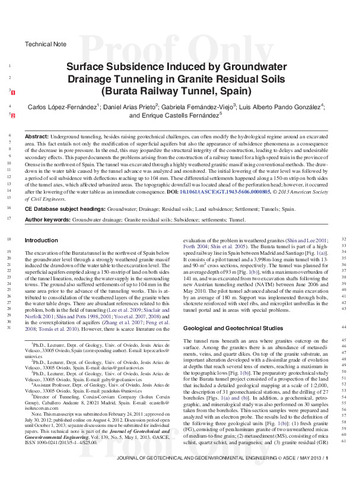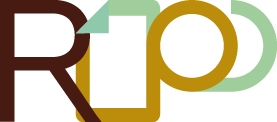Surface subsidence induced by groundwater drainage tunneling in granite residual soils (Burata railway tunnel, Spain)
Palabra(s) clave:
Subsidence
Tunnel
Engineering Geology
Fecha de publicación:
Editorial:
American Society of Civil Engineers
Versión del editor:
Citación:
Resumen:
Underground tunneling, besides raising geotechnical challenges, can often modify the hydrological regime around the excavated area. This fact entails not only the modification of superficial aquifers, but generally the appearance of subsidence phenomena as a consequence of the decrease in pore pressure. In the end, this may jeopardize the structural integrity of the construction, leading to delays and undesirable secondary effects. This technical note documents the problems arising from the construction of a railway tunnel for a highspeed train in the province of Orense (Northwest Spain). The tunnel was excavated through a highly weathered granitic massif using conventional methods. The drawdown in the water table caused by the tunnel advance was analyzed and monitored. The initial lowering of the water level was followed by a period of soil subsidence with deflections reaching up to 104 mm. These differential settlements happened along a 150 m strip on both sides of the tunnel axes, affecting urbanized areas. The topographic downfall was located ahead of the perforation head, but occurred after the lowering of the water table, as an immediate consequence
Underground tunneling, besides raising geotechnical challenges, can often modify the hydrological regime around the excavated area. This fact entails not only the modification of superficial aquifers, but generally the appearance of subsidence phenomena as a consequence of the decrease in pore pressure. In the end, this may jeopardize the structural integrity of the construction, leading to delays and undesirable secondary effects. This technical note documents the problems arising from the construction of a railway tunnel for a highspeed train in the province of Orense (Northwest Spain). The tunnel was excavated through a highly weathered granitic massif using conventional methods. The drawdown in the water table caused by the tunnel advance was analyzed and monitored. The initial lowering of the water level was followed by a period of soil subsidence with deflections reaching up to 104 mm. These differential settlements happened along a 150 m strip on both sides of the tunnel axes, affecting urbanized areas. The topographic downfall was located ahead of the perforation head, but occurred after the lowering of the water table, as an immediate consequence
Patrocinado por:
Proyecto MARCAS, CTM2009-11522
Colecciones
- Artículos [36460]
- Geología [544]
- Investigaciones y Documentos OpenAIRE [8109]
Ficheros en el ítem




